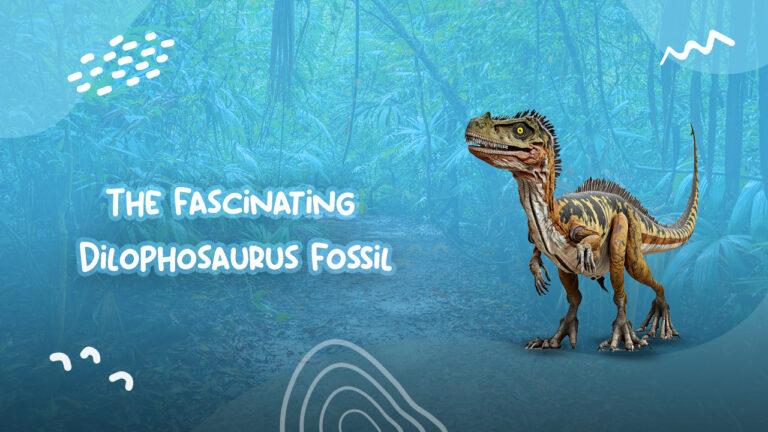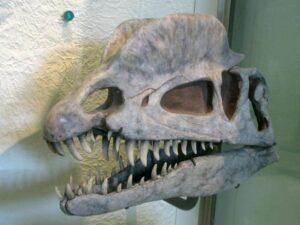The Fascinating Dilophosaurus Fossil

Have you ever heard of the Dilophosaurus or Dilophosaurus Fossil? It’s a species of dinosaur that lived during the Early Jurassic period, and its fossils have been uncovered all over the world. This fascinating creature has captivated dinosaur experts for years, and researchers continue to learn more about it every day. Let’s take a closer look at this incredible fossil!
The Dilophosaurus Fossil
The first Dilophosaurus fossil, initially dubbed “Megalosaurus wetherilli,” was discovered in Arizona in 1942 by Jesse Williams. It wasn’t until 1970 that this fossil was officially named and classified as Dilophosaurus by Dr. Samuel Welles. Since then, the findings of Dilophosaurus fossils have been limited, with only a few specimens being unearthed in the United States and China.
Unraveling the True Identity
Despite limited Dilophosaurus fossil evidence, recent advancements in technology and extensive research have led to significant insights into the true nature of the Dilophosaurus. Contrary to earlier assumptions of it being a primitive and less-developed member of the theropod lineage, recent studies suggest that the Dilophosaurus may have been more advanced and diverse than initially thought.
Although many aspects of the Dilophosaurus fossil remain shrouded in mystery, there’s no denying the fact that it has certainly enriched our understanding of the complex evolutionary history of Earth’s ancient inhabitants.
Dilophosaurus–Ancient Apex Predator
Today, we know that the Dilophosaurus was a bipedal carnivore that was roughly 20 feet long and weighed approximately 1 ton. It had small arms equipped with claws and powerful legs that enabled it to move quickly over short distances. It also had two crests on its head, which may have been used for display purposes or to help regulate body temperature. Finally, its diet likely consisted primarily of other small animals such as lizards, birds, and mammals.
Appearance and Behavior of Dilophosaurus
The discovery of the Dilophosaurus Fossil sheds light on this medium-sized carnivore, standing about 6 feet tall and measuring up to 20 feet long from head to tail. It boasted an elongated neck, two crests on its head, and three claws on each hand. Scientists speculate it may have had feathers, considering its close relationship with feathered dinosaurs like Archaeopteryx. Additionally, it’s believed to have been an active hunter, chasing down prey in packs akin to modern wolves.
Distinctive Features
Apart from the iconic cranial crests, the Dilophosaurus showcased several unique features. Measuring up to 20 feet in length and weighing nearly half a ton, it flaunted a slender, lightweight body structure. This structural design allowed for greater agility, despite being relatively large in comparison to other early theropods.
These predatory beasts were also characterized by their elongated heads, powerful jaws, and long, sharp, curved teeth designed for tearing flesh. Contrary to its depiction in popular media like the Jurassic Park franchise, there is no scientific evidence supporting the theory that Dilophosaurus could spit venom or had a neck frill.
Cultural Significance of the Dilophosaurus Fossil
Dilophosaurus fossils were first discovered in 1940 in Arizona’s Petrified Forest National Park. Since then, it has become an iconic part of pop culture, appearing in various films and television shows. For example, in Jurassic Park (1993), a fictional version of the Dilophosaurus appears as a venomous creature capable of spitting poison at its enemies—a trait not found in any real-life species of dinosaurs!
The discovery of the Dilophosaurus fossil has been hugely significant for our understanding of early dinosaur evolution. For example, thanks to this find we now know that dinosaurs evolved from smaller ancestors much earlier than previously thought and that they were able to evolve into larger sizes relatively quickly. In addition, since this particular fossil is well-preserved we can learn more about its anatomy than would otherwise be possible if it was incompletely preserved or fragmented like many other fossils are.
Dilophosaurs as Scientific Evidence
While popular culture often exaggerates certain aspects of dinosaurs for entertainment purposes, scientists rely on fossils like those from the Dilophosaurus for evidence about their behavior and evolution throughout history.
For example, by studying the size and shape of Dilophosaurus bones, researchers can gain insight into how fast these creatures moved or what type of food they ate. This kind of scientific evidence is invaluable when trying to understand how different species evolved!
Ongoing Debates and Controversies
As with any scientific discovery, the Dilophosaurus fossil has been the subject of various debates and controversies over the decades, with researchers striving to piece together its intricate life story. Theories surrounding the purpose of their cranial crests have ranged from being involved in thermoregulation to being used for display during courtship rituals.
The addition of venom-spitting and neck frills in popular media representation has only fueled further interest and speculation. Despite ongoing uncertainty, the pursuit to unravel the life and times of the Dilophosaurus fossil continues to enthrall and inspire the scientific community.
Conclusion
The story behind the Dilophosaurus fossil is truly remarkable – from its discovery in 1940 to its lasting presence in popular culture today! Its fossil continues to provide valuable scientific evidence about this species as well as other dinosaurs that lived during the Early Jurassic period.
The Dilophosaurus fossil is one of our most important finds when it comes to understanding early dinosaur evolution. Its well-preserved state has allowed us to piece together a clearer picture of what these creatures looked like and how they lived millions of years ago – something which wouldn’t be possible without this incredible find!
With discoveries being made every day about dinosaurs like the Dilophosaurus and the Dilophosaurus fossils, it’s clear why this field continues to spark fascination around the world – even after all these years!
Have you heard about The Top 10 Ugliest Dinosaurs? check it out and let’s find out.

Top posts
related articles
Discover The Top 10 Longest Dinosaur Names
Dinosaurs, the ancient giants that once roamed the Earth, continue to capture our imagination. While
Discover the Amazing Dinosaur with 500 Teeth
Dinosaurs have always fascinated us with their colossal size, unique features, and intriguing mysteries. One
Acheroraptor – Tiny But Fierce Dinosaur
The dinosaur world is undoubtedly fascinating, and the relative discovery of the Acheroraptor is no
Amazing Cryolophosaurus- An Epic Tale
Cryolophosaurus, also known as the ‘Antarctic King’, was a fierce and fascinating dinosaur that existed
Discover Torosaurus And Its Mysterious Identity
Dinosaurs don’t exist anymore, but their fossils still fascinate us. Paleontologists scour the earth to
Corythosaurus–Exploring Its Wondrous World
The world of dinosaurs never stops fantastic us. From the huge T-rex to the tiny



